CV Examples | Example of a good CV (+ biggest mistakes to avoid!)
Let’s face it, some CVs are great, some good and others downright horrible. If you’re looking for a good CV sample for inspiration to help you write your perfect CV, you’ve come to the right place!
Below you will find two different CVs:
- Excellent CV sample: Professionally written to impress employers and secure job interview invitations.
- Bad CV example: An unimpressive and poorly written CV that doesn’t have a chance to impress the employer or secure job interviews.
Make sure yours doesn’t look like this!
We’ll provide you section by section breakdown of each of these CVs to give you tips on the best CV writing practices to follow, common mistakes to avoid, and how to write a compelling CV to secure job interviews.
Cool, right? Lets start!
Example of an excellent CV
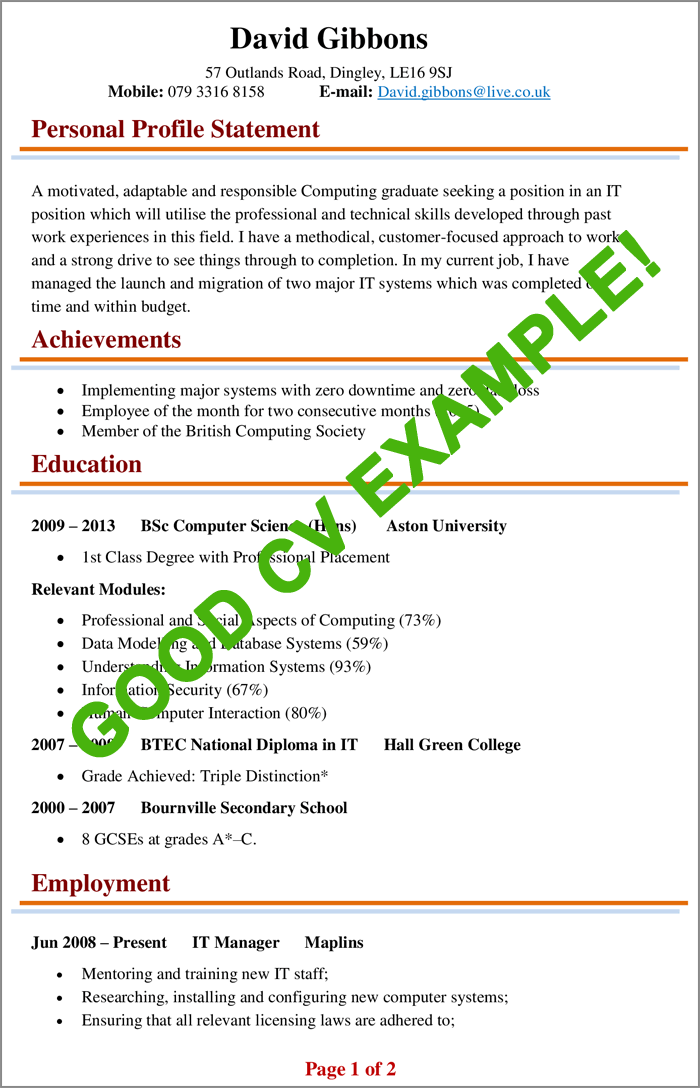
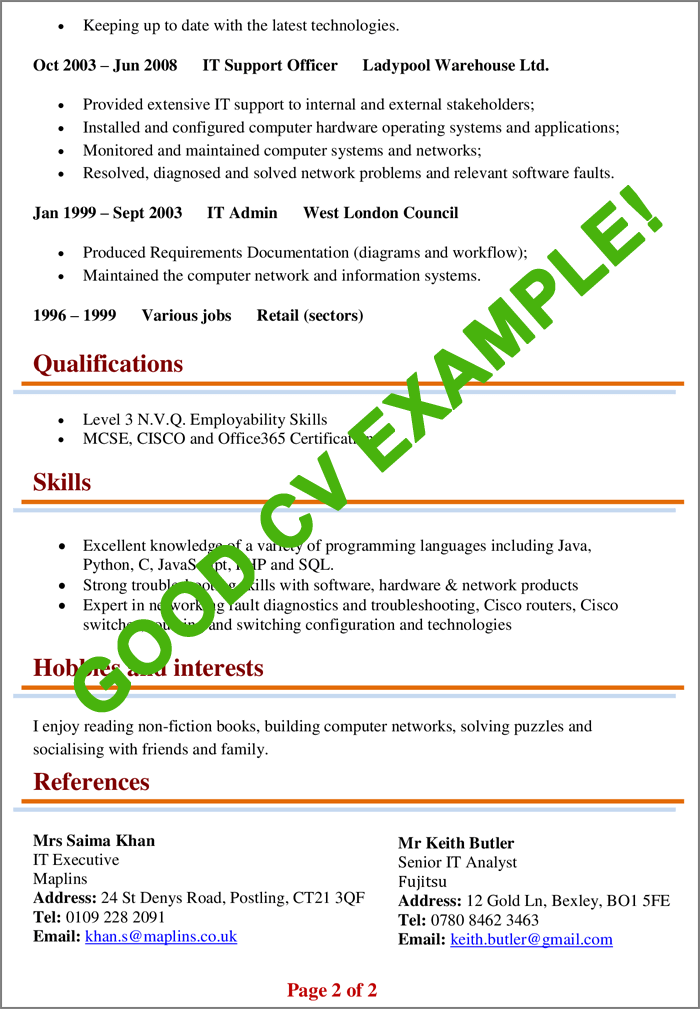
What makes this CV effective?
- It has a great format and layout that makes it easy to read.
- Bullets and short sentences and used appropriately.
- The CV is fully adapted to the job for which the candidate is applying.
- A minimal amount of color and design is used to enhance the presentation and visual appeal of the CV.
- It contains all the information that a standard CV should contain.
- The same format for dates is used throughout the chapters.
Example of a bad CV
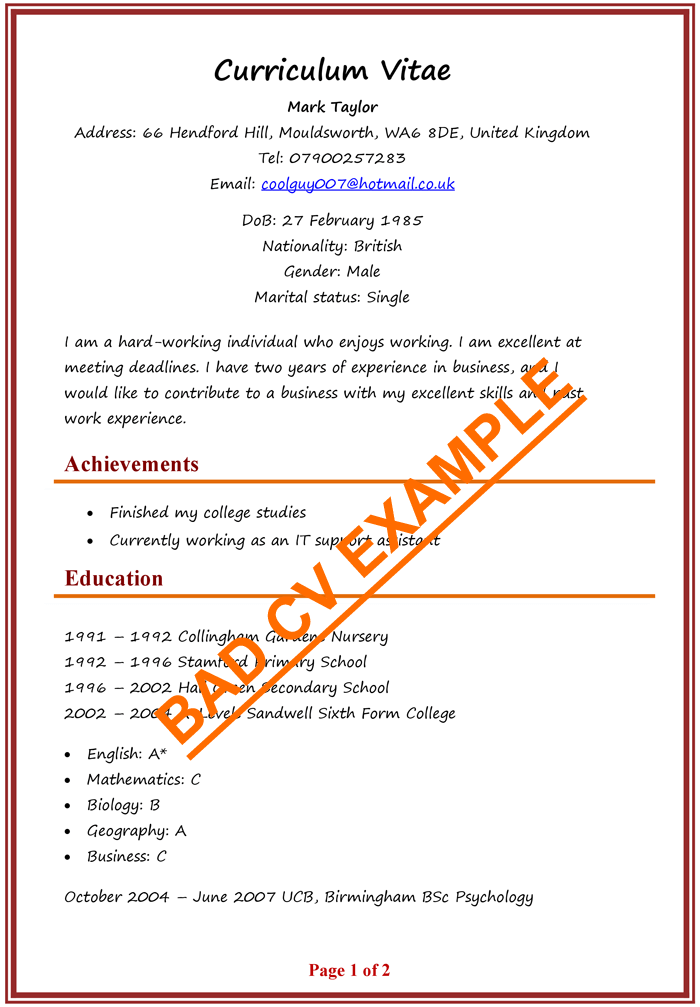
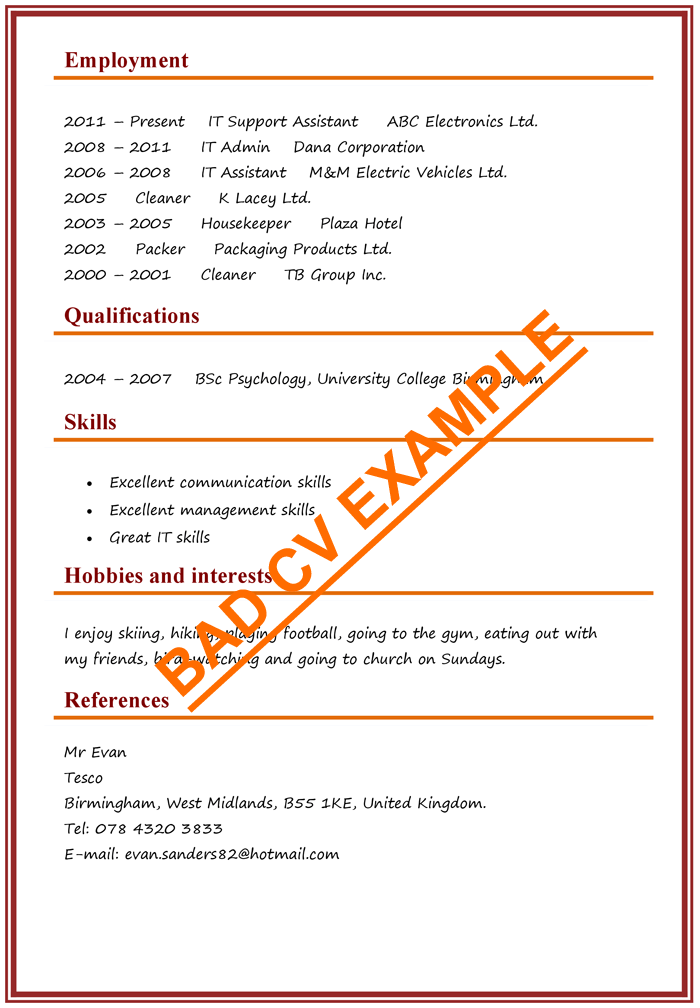
What makes this CV ineffective?
- At first glance, this CV example looks very general, boring and boring.
- Poorly written and poorly structured.
- The resume contains vague statements that are not supported by real world examples.
- The resume contains too much irrelevant and / or outdated information.
- The order and presentation of the information is not satisfactory.
- The font is inappropriate and difficult to read.
Section-by-section breakdown of the good and bad CVs
1. Personal details
The personal details section appears at the top of your CV and is the first thing a potential employer will see.
Bad example:
Curriculum Vitae
Mark Taylor
Address: 66 Hendford Hill, Mouldsworth, WA6 8DE, United Kingdom
Tel: 07900257283
Email: coolguy007@hotmail.co.uk
DoB: 27 February 1985
Nationality: British
Gender: Male
Marital status: Single
Comments & tips for improvement:
- Title: The title of a CV, the candidate’s full name should be written in capital, bold letters and centered on the page (not a CV or CV).
- Email: Email address should be professional (eg first and last name), definitely nothing like coolguy007@hotmail.co.uk!
- Address: There is no need to use the “Address” prefix before the main address, and the address should be written as short as possible to save valuable space for more important information.
- Nationality, date of birth, gender, and marital status are optional details that are best left outside of the resume if there is no particular benefit for their inclusion.
Good example:
David Gibbons
57 Outlands Road, Dingley, LE16 9SJ
Mob: 079 3316 8158
Email: David.gibbons@live.co.uk
That’s much better, right?
2. Personal Profile Statement
A personal profile is a short statement that tells the employer about your personal skills, qualifications, experiences and career goals.
Bad example:
I am a hardworking individual who likes to work. I am excellent at meeting deadlines. I have two years of experience in business and I would like to contribute to a business with my excellent skills and past work experience.
Comments & tips for improvement:
- The personal profile needs to be effective and outline the candidate’s personal qualities regarding the role he or she is applying for.
- The candidate should avoid using vague statements that are not specific enough to bear any weight or meaning. “Two years of experience in business”… what kind of experience? What did you do? “My excellent skills”… what skills? Try to be as specific as possible and add real-world examples to your personal profile statement!
- All sections of a CV, except personal information, must be appropriately labeled.
How do I write an impressive CV?,#What is the best CV format to use?,#Do and don’ts of a good CV?,#What should not go on a CV?,#How can I make my CV stand out 2020?,#What employers look for in a CV?,#Should you lie on your CV?,#How do you end a CV?,#What is dos and don ts?,#What is a good CV layout?,#Which is better CV or resume?,#What makes a good CV 2020?,#How a good CV should look like?,#How do I write my first CV?,#How long should your CV be?,#How can I make my CV look attractive?,#How can I make my CV stand out visually?,#Can you go to jail for lying on your CV?,#Can you go to jail for lying on a resume?,#Can you be sacked for lying on your CV?
Good example:
Personal Profile Statement
A motivated, adaptable and responsible IT graduate seeking a position in an IT position that will use professional and technical skills developed through past work experience in this field. I have a methodical, customer-focused approach to work and a strong urge to see things until they’re done. In my current job, I managed the startup and migration of two large IT systems that were completed on time and within budget.
3. Achievements
The Achievements section contains, as the name suggests, a short list of impressive achievements or achievements that are a testament to your skills, abilities, determination and desire to succeed.
Bad example:
- Finished my college studies
- Currently working as an IT support assistant
Comments & tips for improvement:
- The phrase “he has finished my university education” is very vague and does not tell the employer anything about the candidate’s academic performance or grades. The purpose of this section is to impress the employer with basic facts or figures, not vague statements!
- The candidate is unclear why working as an IT support assistant is an achievement they are particularly proud of.
Good example:
Achievements
- Implementing large systems with zero downtime and zero data loss
- Employee of the month for two consecutive months (2015)
- Member of the British Computing Society
Very impressive!
4. Education
The education section contains brief information about your education and qualifications background. Together with the employment and work experience section, it forms a large part of your CV.
Bad example:
1991 – 1992 Collingham Gardens Nursery
1992 – 1996 Stamford Primary School
1996 – 2002 Hall Green Secondary School
2002 – 2004 A-Levels Sandwell Sixth Form College
- English: A*
- Mathematics: C
- Biology: B
- Geography: A
- Business: C
October 2004 – June 2007 UCB, Birmingham BSc Psychology
Comments & tips for improvement:
- The entries in this section must be in chronological order (ie, most recent first).
- A bachelor’s degree is one of the most important academic achievements of a person’s career and is an excellent selling point! The candidate should focus much more on this competence by mentioning the grades and listing the relevant modules.
- Grade classification / grade is missing.
- This section contains too many irrelevant and outdated tutorials! What is the point of mentioning the kindergarten and primary school in a graduate’s resume? As a general rule, anything that does not strengthen or add value to a person’s application should be neglected.
Good example:
Education and Training
2009 – 2013 BSc Computer Science (Hons) Aston University
- 1st Class Degree with Professional Placement
Relevant Modules:
- Professional and Social Aspects of Computing (73%)
- Data Modelling and Database Systems (59%)
- Understanding Information Systems (93%)
- Information Security (67%)
- Human-Computer Interaction (80%)
2007 – 2009 BTEC National Diploma in IT Hall Green College
- Grade Achieved: Triple Distinction*
2000 – 2007 Bournville Secondary School
- 8 GCSEs at grades A*–C.
That’s much better!
5. Employment and work history
The employment and work experience section of your CV contains information about your previous jobs and work history. Employers are particularly interested in this department because relevant work experience is invaluable and often a basic requirement for many jobs.
Bad example:
2011 – Present IT Support Assistant ABC Electronics Ltd.
2008 – 2011 IT Admin Tesco
2006 – 2008 IT Assistant M&M Electric Vehicles Ltd.
2005 Cleaner K Lacey Ltd.
2003 – 2005 Housekeeper Plaza Hotel
2002 Packer Packaging Products Ltd.
2000 – 2001 Cleaner TB Group Inc.
Comments & tips for improvement:
- The following four details are required for each entry: name of the company worked for, start and end dates (month / year format), job title, and main tasks performed. In the CV example above, the basic responsibilities or duties performed are missing so the employer will have no idea what the candidate is doing in these roles!
- The candidate must skip unrelated or otherwise unimportant work experience. Having worked as a cleaner in 2000 will not make the candidate a better IT professional in 2019!
- Entries are badly formatted and aligned. The presentation of information (ie order and structure) is just as important as the content!
Good example:
Employment history
Jun 2008 – Present IT Manager Maplins
- Consulting and training for new IT staff;
- Researching, installing and configuring new computer systems;
- Ensuring compliance with all relevant license laws;
- Keeping up to date with the latest technologies.
Oct 2003 – Jun 2008 IT Support Officer Ladypool Warehouse Ltd.
- Provided comprehensive IT support to internal and external stakeholders;
- Installed and configured computer hardware operating systems and applications;
- Computer systems and networks monitored and maintained;
- Solved, diagnosed and resolved network problems and related software bugs.
Jan 1999 – Sept 2003 IT Admin West London Council
- Generated Requirements Documentation (diagrams and workflow);
- He protected the computer network and information systems.
1996 – 1999 Various jobs Retail (sectors)
Perfect!
6. Qualifications
The qualifications section is an optional part of your resume and should include a list of your vocational education, courses and / or qualifications.
Bad example:
2004 – 2007 BSc Psychology, University College Birmingham
Comments & tips for improvement:
- There is no need to re-mention here, as the undergraduate degree is already mentioned in the education section.
- If the candidate does not have other additional qualifications to be listed here, this section should be removed from the person’s CV.
Good example:
- Level 3 N.V.Q. Employability Skills
- MCSE, CISCO and Office365 Certifications
7. Skills
In the Skills section you should include a list of your key skills and abilities that will help you do the advertised job well. Remember, only include skills that are relevant, transferable, and add value to your practice.
Bad example:
- Excellent communication skills
- Excellent management skills
- Great IT skills
Comments & tips for improvement:
- Items on the list are very ambiguous and not supported by examples from real life situations! It gives the impression that the candidate is listing a set of skills just to list them, without having these skills.
- It is recommended that the entries in this section be specific and descriptive.
Good example:
- Excellent knowledge of various programming languages including Java, Python, C, JavaScript, PHP and SQL.
- Strong troubleshooting skills with software, hardware and networking products
- Expert in network fault diagnosis and troubleshooting, Cisco routers, Cisco switches, routing and switching configuration and technologies
Looking through this list of skills will give any employer the impression that this candidate knows exactly what she’s talking about!
8. Hobbies and interests
You should use the hobbies and interests section of your resume to show that you are a versatile person interested in extracurricular activities and the community.
Bad example:
I love skiing, hiking, playing football, going to the gym, eating with my friends, watching the birds and going to church on Sundays.
Comments & tips for improvement:
- Do not mention unrelated hobbies on your CV that do not add any added value to your application.
- Do not disclose political or religious affiliations.
- Avoid listing too many hobbies.
Good example:
Hobbies and interests
I enjoy reading non-fiction books, networking, solving puzzles, and socializing with my friends and family.
9. References
References section is the last section of your resume, which includes the contact information of two people who know you well, have worked with you before and can vouch for your employer.
If you decide not to include references to your resume, you can simply write “references available on request”.
Bad example:
Mr Evan
Tesco
Birmingham, West Midlands, B55 1KE, United Kingdom.
Tel: 078 4320 3833
E-mail: evan.sanders82@hotmail.com
Comments & tips for improvement:
- The referee’s name needs to be written in full.
- The referee’s job title/position is missing
- The address is not complete
Good example:
Mrs Saima Khan
IT Executive
Maplins
Address: 24 St Denys Road, Postling, CT21 3QF
Tel: 0109 228 2091
Email: khan.s@flashelectronics.co.uk
Congratulations! You should now have a pretty good idea of how to write your perfect CV by following the standard CV writing guidelines and avoiding some common mistakes.
More CV examples
Check out the templates below for more CV samples:
Sales CV example
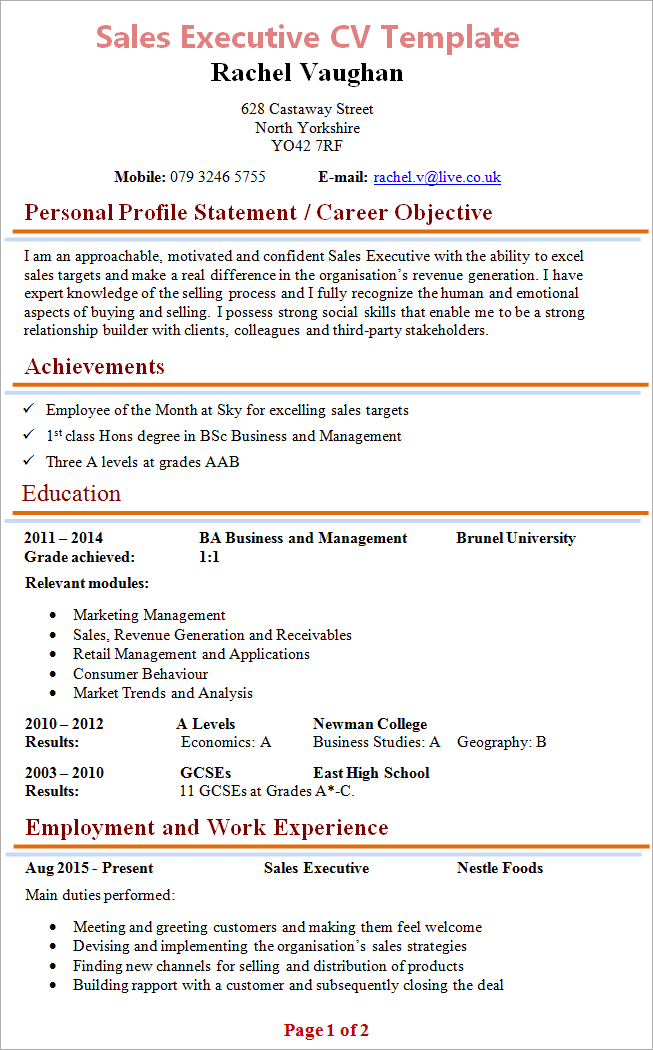
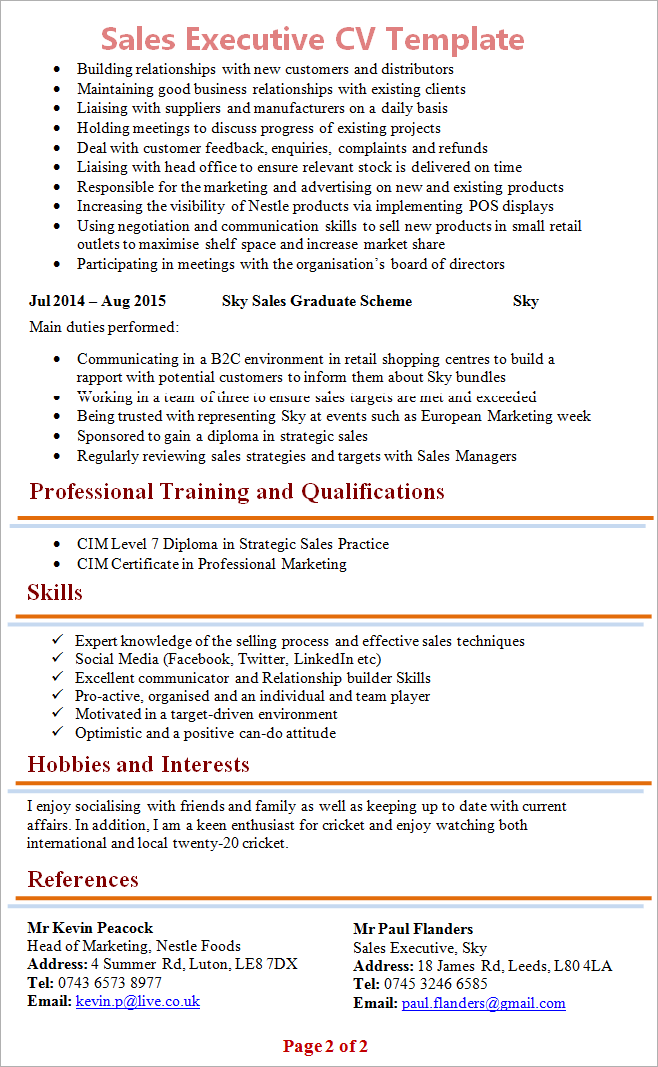
(Download: sales CV template)
Engineering CV example
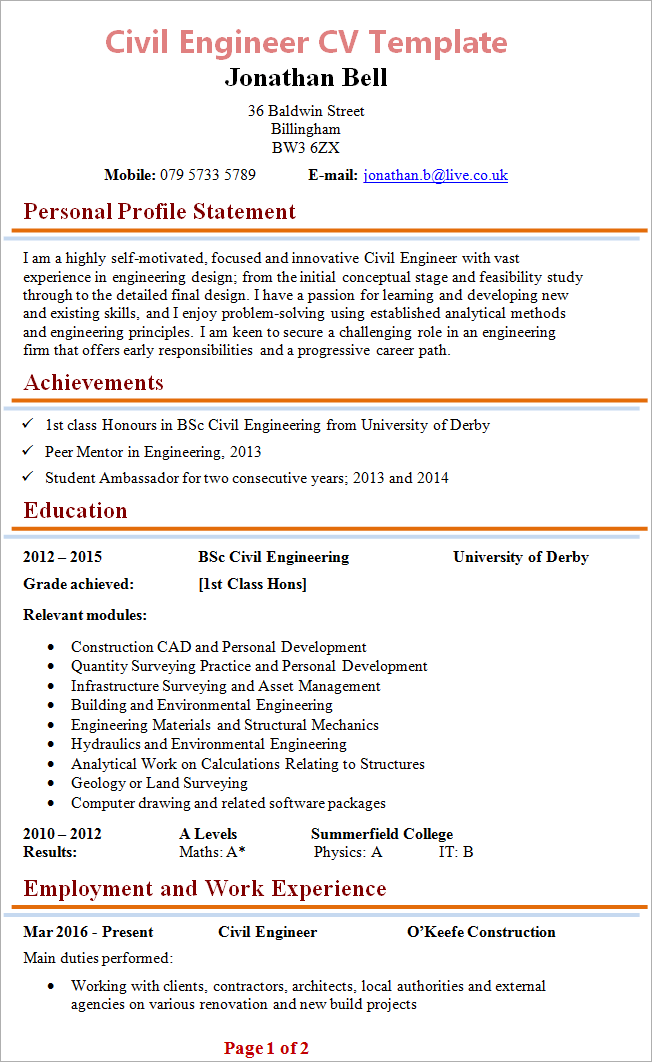
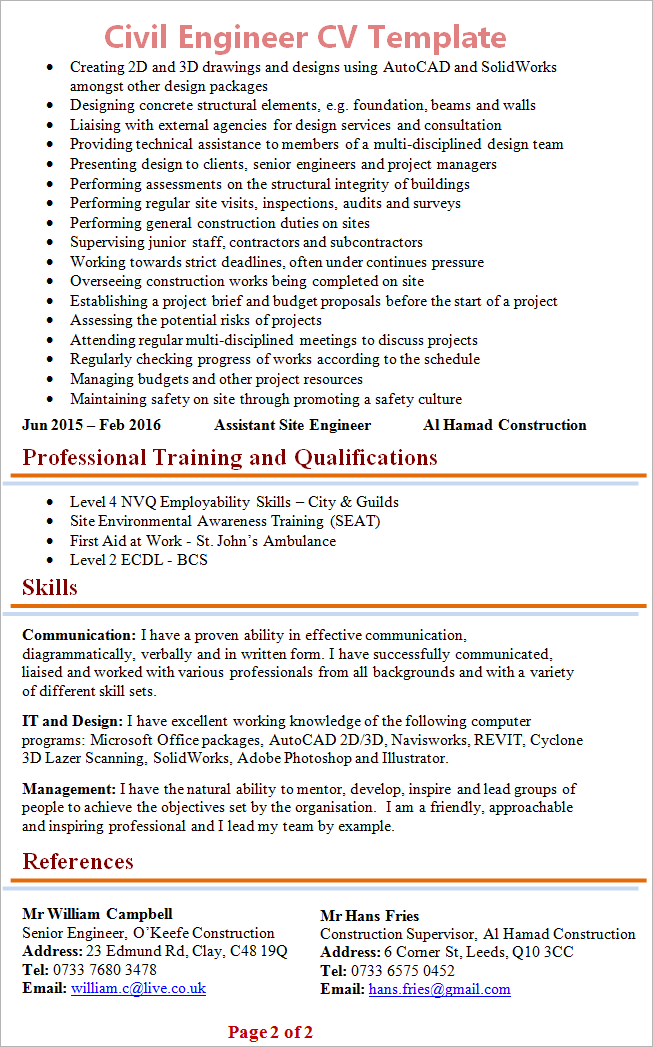
(Download: engineering CV template)
Finance CV example
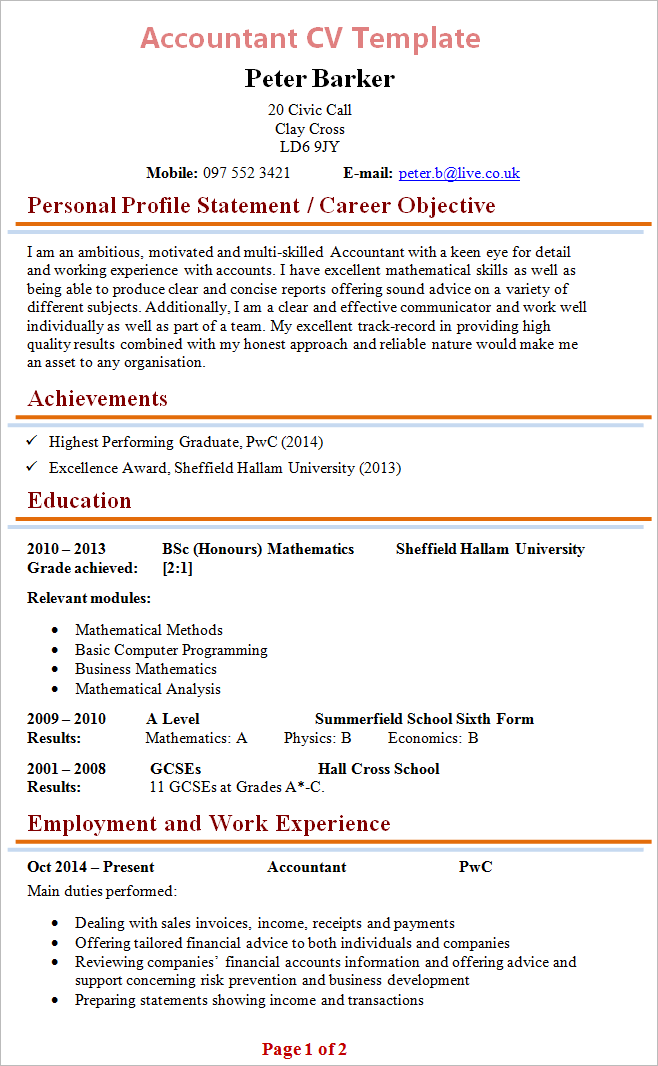
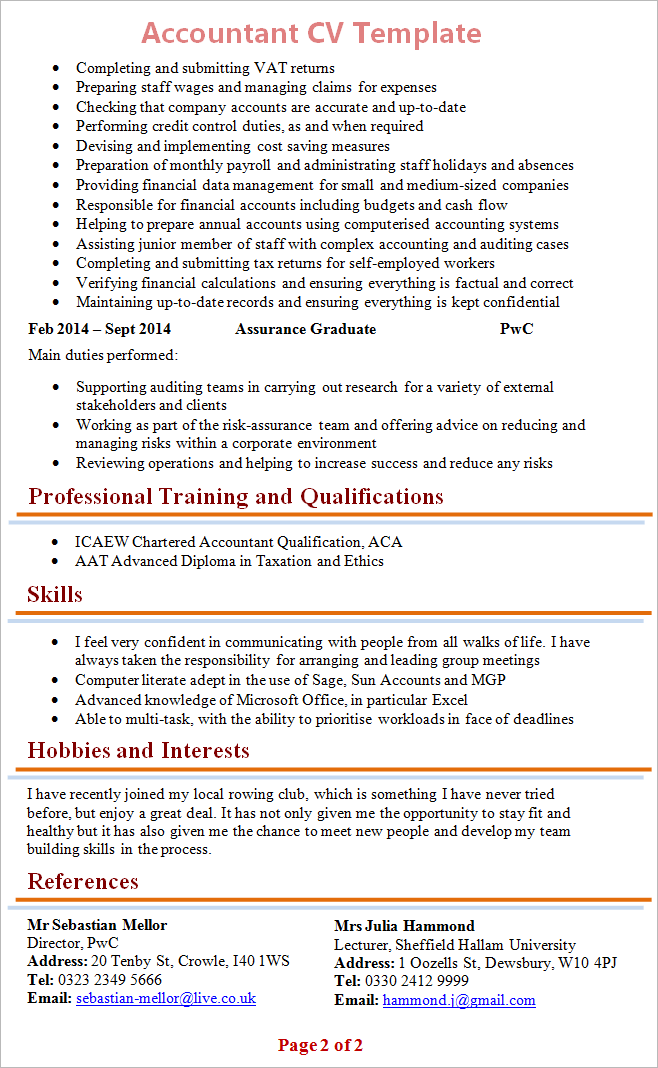
(Download: finance CV example)
Education CV example
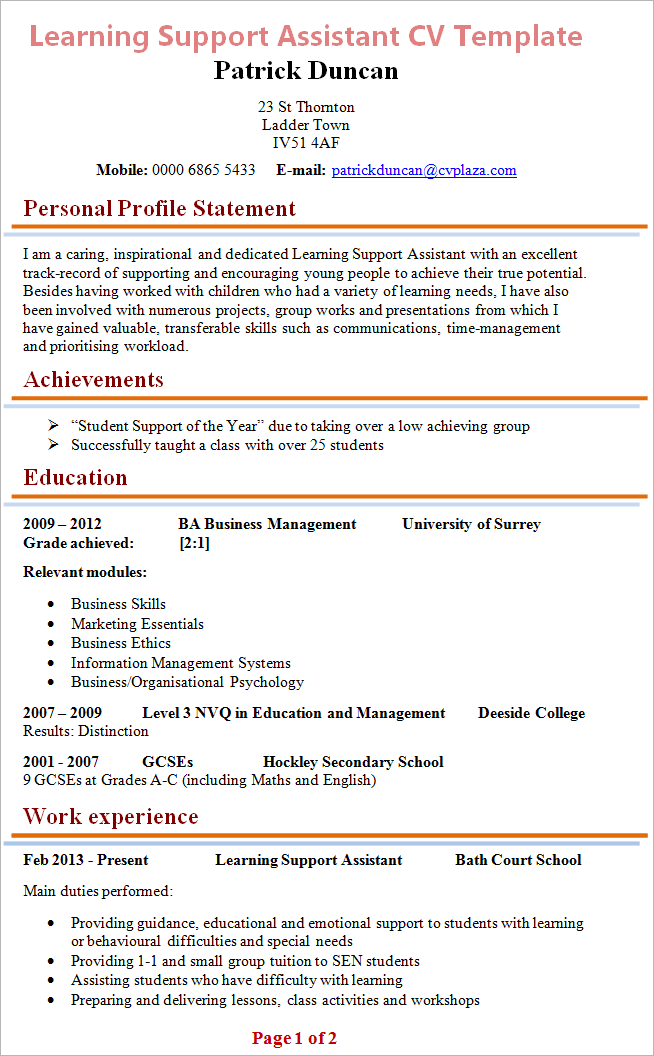
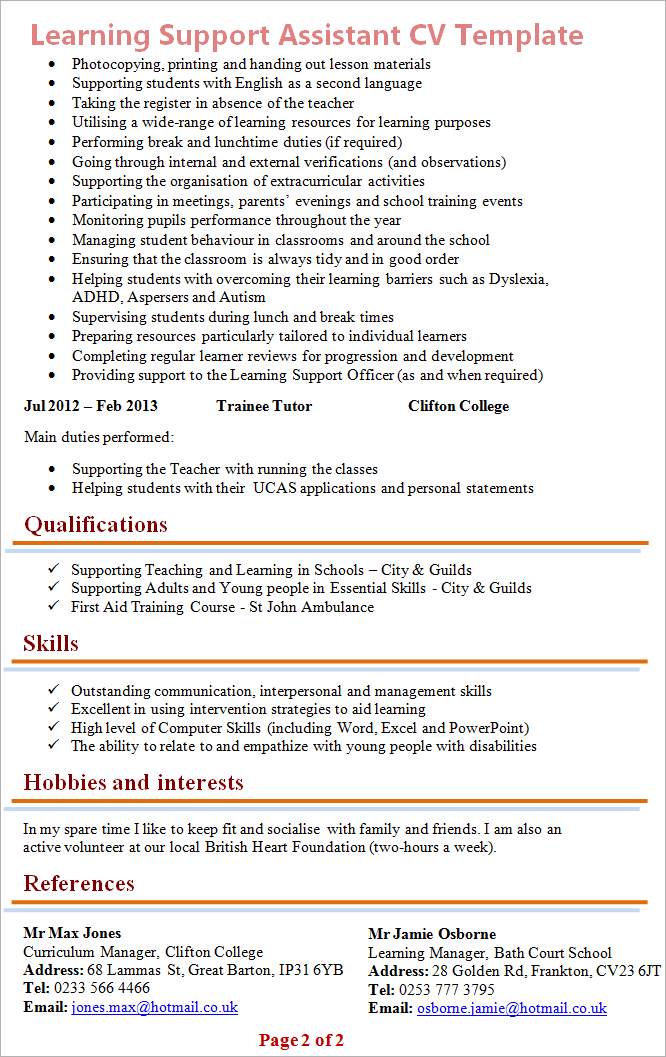
(Download: educational CV template)
Didn’t find what you were looking for? Check out these great CV examples of over 100 jobs from 18 different business sectors!
Different types of CVs – which format is appropriate for you?
School leaver CV
School leaving CV is an ideal format for young people who have just finished school or university and have little or no work experience. This CV template is also recommended for newcomers to the business world.
- The ideal length for this CV should be 1 A4 page long.
- The candidate should place a lot of emphasis on transferable skills, qualifications and abilities rather than work experience or qualifications.
Graduate CV
Graduate CV is an ideal format for college students, alumni, and young professionals with at least a bachelor’s degree and some work experience. This CV template is also the recommended format for most people.
- The ideal length for this resume should be 2 A4 pages.
- Candidates should focus too much on relevant qualifications, work experience or vocational training.
Skills-based CV
A skills-based CV, also known as a functional CV, is an ideal format for candidates who do not have relevant qualifications or work experience but who have transferable skills that can help them do the job well.
- Too much emphasis should be placed on skills, abilities and personal qualities that may be useful for the advertised role.
- Each skill or quality needs to be supported by real-world examples (ie how and where these skills are used in real life situations).
Academic CV
As the name suggests, an academic CV is a CV format used by teachers, researchers, and academics. Academic CVs are used to apply for teaching or research positions and focus a high degree of academic achievement and qualifications.
- Unlike traditional resumes, there are also several additional sections devoted to research interests, publications, conference presentations, teaching events, awards and professional memberships.
- There is no ideal length for this CV format as it largely depends on the candidate’s level of experience, education, seniority, etc. It depends. Typically, they are 3-5 pages long.
BONUS: CV writing tips
1. Use short sentences and bullet points
It’s important to remember that employers tend to scan resumes rather than read them in detail. Using short sentences and bullets will increase the readability and impact of your resume.
2. Select an appropriate font
CV yazmak için en sık önerilen yazı tipleri Times New Romans (12 pt), Arial (11 pt), Verdana (11 pt) ve Helvetica’dır (12 pt).
3. Tailor your CV to the particular job
Each CV should be carefully modified and tailored to the job you are applying for. Include only relevant information on your CV and use the same keyword phrases and terms as in a job posting.
4. Use CV templates and examples
Some applicants make the mistake of writing their resumes from scratch. You don’t need to reinvent the wheel! Save even more time by using CV templates and CV samples for guidance and inspiration.
5. Get expert help & advice
Writing the perfect CV is an art! It is a good idea to have your CV checked by career professionals who specialize in job applications.

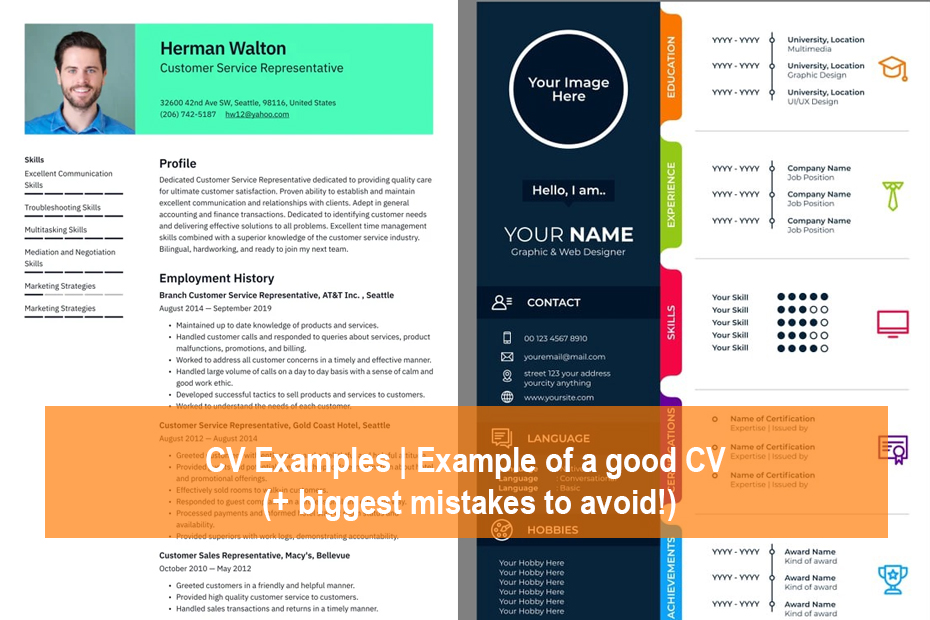







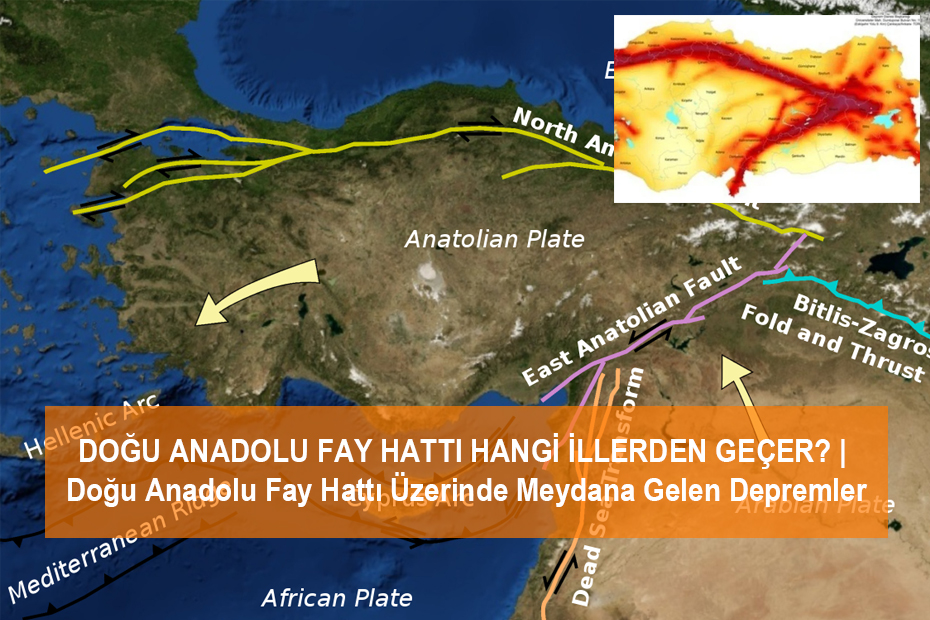




Comments